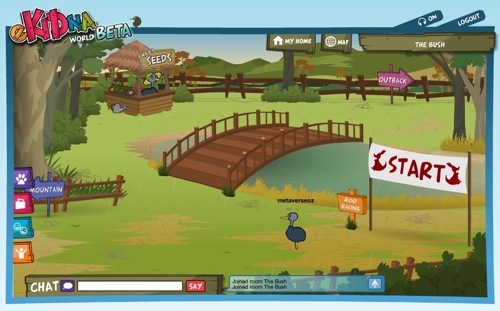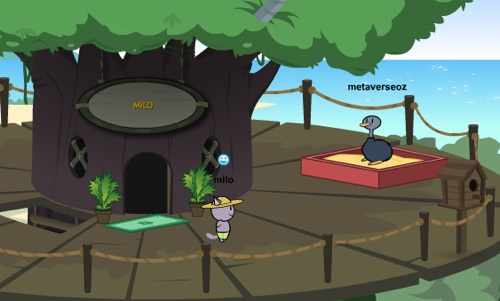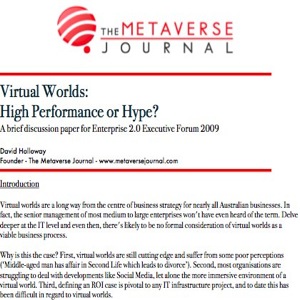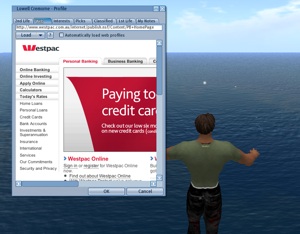I spent this morning at a session organised for a team of French innovators called ‘Lead Educators : Virtual Worlds and the Immersive Web’ . I’ll talk more about that in another post but I wanted to devote this one to a topic we’ve covered previously: Skoolaborate.
Since that time, there’s been some incredible progress, with more than forty schools now involved. I had the opportunity to see Skoolaborate up close at Sydney’s MLC School today. Director of Online Learning at MLC and Skoolaborate‘s founder, Westley Field, spent an hour or so presenting the outcomes to date from the project, which was established in 2007. Essentially, the outcomes demonstrate the power of a well designed 2D content delivery system combined with the use of Skoolaborate‘s islands in Second Life. Here’s a small example of such an outcome:
The main messages I took out of the session aren’t news to educators working regularly with virtual worlds, but they bear repeating for the rest of us:
1. Virtual worlds provide a powerful complementary role within the broader learning context
2. Some students immerse themselves in the virtual world aspects, others don’t like it, and most fall somewhere in the middle
3. Having an evangelist within a school for learning innovations like Skoolaborate is crucial, but having a supportive Principal is even more important
It’s not an entirely rosy picture for Skoolaborate though. Funding has improved although it remains an ongoing battle, and the time commitment from educators involved is significant. Most importantly, I detected a level of frustration around some inequalities existing in accessing Skoolaborate. One of the most stark illustrations of inequality with it is due purely to State Government ineptitude.
Let’s use the NSW Department of Education and Training (DET) as an example. Essentially, no NSW (or Australian) public schools are involved with Skoolaborate. The reason: schools falling under the control of the NSW DET cannot access Second Life. Why? The usual response on blocking content is around protecting children from unwanted information. The thing is, in the case of Skoolaborate, educators have already identified the issue and solved it. Participating schools are set up in Second Life so that only authenticated students and teachers can access in-world activities. In NSW, the private schools involved have mandatory ‘working with children’ checks and worldwide each participating school must complete their own relevant police checks for each adult participant. In fact, successful registration to access any content requires completion of the police check. This would have to make Skoolaborate one of the most child-secure online learning environments in existence.

What makes this issue particularly frustrating is that key bodies within the NSW DET actually understand that initiatives like Skoolaborate are delivering for students. The NSW DET’s own Centre for Learning Innovation (CLI) has staff well and truly across virtual worlds, and there’s recognition from its General Manager down that immersive worlds will be key to further online learning initiatives. 
Given that any school should be attempting to prepare its students for the realities of the outside world, and that units like the CLI already see the potential of virtual worlds for education, why would the DET have a policy of preventing access? It’s either a politically motivated call or a case of plain ignorance at the higher levels of the DET.
Either way, some serious questions need to be asked on how long the situation will occur. This may be a case of failing to protect children by not equipping them with appropriate knowledge. How will kids know how to navigate emerging technologies if they have no exposure in their schooling?
Update: Westley Field has contacted me to correct the assertion that no Australian public schools are involved with Skoolaborate – there are in fact public schools involved, just none from NSW. He also added: “The National Government , through its values in action program is leading the way by supporting us. This support partially based on the fact that we have all three sectors involved. We are very proud of that fact.”
 1. Australian Second Life content developers,
1. Australian Second Life content developers, 


 Karen Orford: It is interesting in that despite the mass far reaching tentacles of the internet the competitors still vary widely from country to country. Club Penguin is the clearly the king of the jungle here in Australia, but in the US it has very serious competition from the likes of Webkinz World, and in the UK European sites such as Habbo have a major grip. However, despite these sites being competitors in that they are online children’s virtual worlds none of them have focused on chat safety in the way ekidnaworld.com
Karen Orford: It is interesting in that despite the mass far reaching tentacles of the internet the competitors still vary widely from country to country. Club Penguin is the clearly the king of the jungle here in Australia, but in the US it has very serious competition from the likes of Webkinz World, and in the UK European sites such as Habbo have a major grip. However, despite these sites being competitors in that they are online children’s virtual worlds none of them have focused on chat safety in the way ekidnaworld.com Today, I had the pleasure of facilitating four small group sessions at the
Today, I had the pleasure of facilitating four small group sessions at the Aside from the group discussions on virtual worlds I facilitated yesterday, the only other time I witnessed them discussed at the
Aside from the group discussions on virtual worlds I facilitated yesterday, the only other time I witnessed them discussed at the
Recent Comments